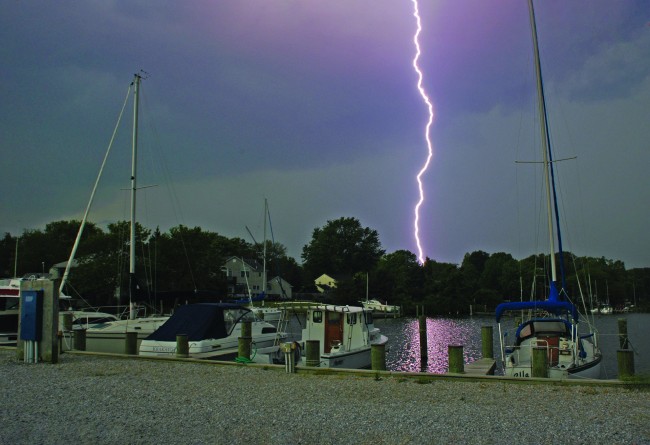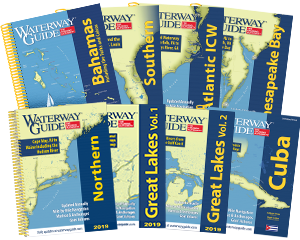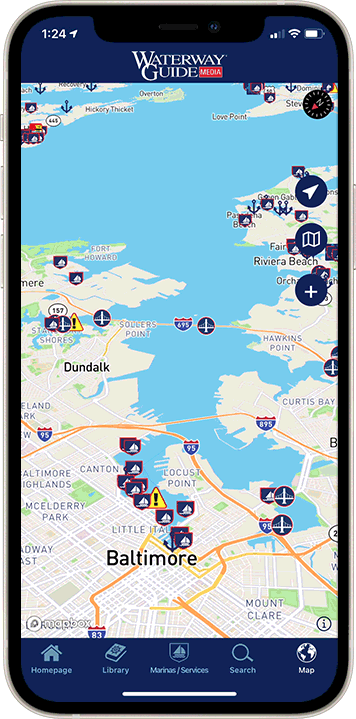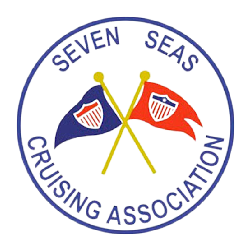Explore Our Latest News & Articles

Having lived and worked on the Chesapeake Bay for the past two decades, I've learned many things about lightning, the most important of which is to be skeptical of anyone who says they can predict what it will do. Lightning in this region is incredibly intense and only second to Florida for the number of boat strikes. I was afforded a valuable learning opportunity concerning lightning and its effects during the 11 years I ran a boatyard in the area, repairing scores of vessels that had been struck and, in some cases, sunk. I've worked with cases in which vessels were struck both ashore and afloat, dockside, at anchor, on a mooring and underway. In one case, a vessel that had been repaired after a strike was struck yet again before it could be retrieved by its owner.
While I won't claim to know enough about lightning to prevent strikes, I can share guidance based on my firsthand, purely anecdotal experiences. It is important to have an understanding of the American Boat and Yacht Council Standard TE-4, "Lightning Protection," which may enable you to install a system that will prevent or at least reduce the degree of lightning-induced damage. It's worth noting that the primary goal of the TE-4 is to afford those aboard the vessel some level of safety and protection from electrocution and side flashes, or arcs that can travel aboard the vessel. Below is purely an interpretation of TE-4, rather than a discussion of alternative or supplementary methods of damage mitigation, of which there are several.
 My first assertion is vessels equipped with bonding systems are less likely to suffer damage or will suffer less damage than those equipped with no bonding system. Even those bonding systems that are partial, in poor repair or otherwise don't meet American Boat and Yacht Council (ABYC) standards are better than none at all. Second, a sound grounding system (i.e., contact between exposed metal and seawater) may also serve to prevent damage to gear, electronics and such. And while there is no proof that a well-grounded vessel is more likely to be struck by lightning, I believe there is ample proof that vessels that lack adequate grounding are more likely to suffer damage (and thereby, crews more likely to be injured).
My first assertion is vessels equipped with bonding systems are less likely to suffer damage or will suffer less damage than those equipped with no bonding system. Even those bonding systems that are partial, in poor repair or otherwise don't meet American Boat and Yacht Council (ABYC) standards are better than none at all. Second, a sound grounding system (i.e., contact between exposed metal and seawater) may also serve to prevent damage to gear, electronics and such. And while there is no proof that a well-grounded vessel is more likely to be struck by lightning, I believe there is ample proof that vessels that lack adequate grounding are more likely to suffer damage (and thereby, crews more likely to be injured).
Two examples bear out this belief, and again these are purely anecdotal rather than scientific. The first, a 40-foot sailing vessel, was struck by lightning while dockside and unattended. It was relatively new and equipped with non-metallic seacocks, an external ballast keel and standard bonding system, one that for the most part meets ABYC E-2 "Cathodic Protection" and E-11 "AC and DC Electrical Systems." The VHF whip at the masthead apparently took the brunt of the hit and melted, sending stainless-steel slag into the cockpit, where it burned the gelcoat and the dodger. The VHF radio still worked, as did all of the remaining gear aboard the vessel, save a handful of blown-out light bulbs and small fuses.
The second case involves a 36-foot trimaran, roughly 10 years old, with no bonding system and non-metallic through-hull fittings, including the transducers. The owner of the vessel called to report that his boat had sunk at his dock. A salvage crew raised the vessel and transported it to the boatyard. The remains of one of the transducers was hanging from its wire, which passed through its original mounting hole, the transducer itself was shattered, and there was damage to the outboard side of the starboard, balsa-cored ama below the waterline, although it was not breached. Electrical systems aboard the boat, once dried out, showed signs of damage, arcing and overheating, and the conclusion was that the vessel was struck by lightning, which exited the transducer and hull, causing it to flood and sink.

Hardware
While compliant bonding and an AC/DC ground system can be beneficial in reducing the damaged caused by nearby (or in some cases direct) lightning strikes, a system that complies completely or at least closely with TE-4 is preferred. I'll be the first to admit that full compliance with TE-4 can be difficult if not impossible; however, most vessels can be made to be in compliance with the bulk of the standard. The following are the components in the system that are of the greatest importance or most often misunderstood.
The air terminal (or "lightning rod") is "…a device at the uppermost point of the lightning protection system that attaches a lightning stroke to the lightning ground system." It's designed to bridge the gap between a lightning bolt and the vessel. Air terminals should be made from solid 3/8-inch copper or a 1/2-inch aluminum rod (the latter being better suited to aluminum spars), the top should be domed, and it should stand 6 feet above the masthead or other ungrounded or non-conductive structures (which is essentially everything).
The ground terminal–essentially the other end of the system–is the connection between the vessel's lightning protection system and the sea. These must be metal and can be made from copper, copper alloy, aluminum, stainless steel or lead, with a minimum thickness of 3/16-inch and 1-square foot of surface area. Existing underwater appendages can fulfill this requirement, particularly an exposed ballast keel, shafts, struts and rudders, provided they are nearly directly under the down conductor (more on that later). In most cases, that excludes everything but a keel; however, these other submerged objects may be electrically tied to the ground terminal, augmenting its effectiveness.
For standalone, dedicated ground terminals, TE-4 calls for the edges to be square, or sharp, rather than radiused, and not filleted with caulk or fairing for maximum dissipation effectiveness. Some studies indicate that the edge is what does the heavy lifting in strike dissipation so the longer it is, the better, meaning a rectangle is more desirable than a square. (Longer is better from the standpoint of reducing side flashes within the vessel as well.) My preference is for a solid 1/4-inch thick, 1- or 2-inch wide copper strip (a band of sorts) that runs parallel with the vessel's centerline placed amidships (or beneath the mast) and totals a minimum of 1 square foot of surface area. Through bolts connect this to the hull and serve as connection points for the primary conductor from the air terminal, as well as secondary conductors from other bonded gear and underwater metals.
Wiring
The primary conductor, which runs from the air terminal (or the base of an aluminum or steel spar) to the grounding conductor, should be tinned, stranded copper with a minimum #4 gauge. It should be as straight and vertical as possible; bends, if necessary, must not exceed 90 degrees and radii no less than 8 inches. Secondary conductors, which connect other fittings, chain plates, tanks, rails, pedestals outriggers and such to the grounding conductor, must be no less than #6, and also as vertical as possible while avoiding sharp bends.
Lightning may be unpredictable; however, even a nearly compliant lightning protection system will almost certainly improve the odds of survivability for vessels operating in strike-prone areas.
###
Steve D'Antonio is a marine systems consultant offering services to boat buyers, owners and the marine industry, as well as an author and photographer. He is an ABYC-Certified Master Technician. Read more from Steve at www.stevedmarineconsulting.com.












